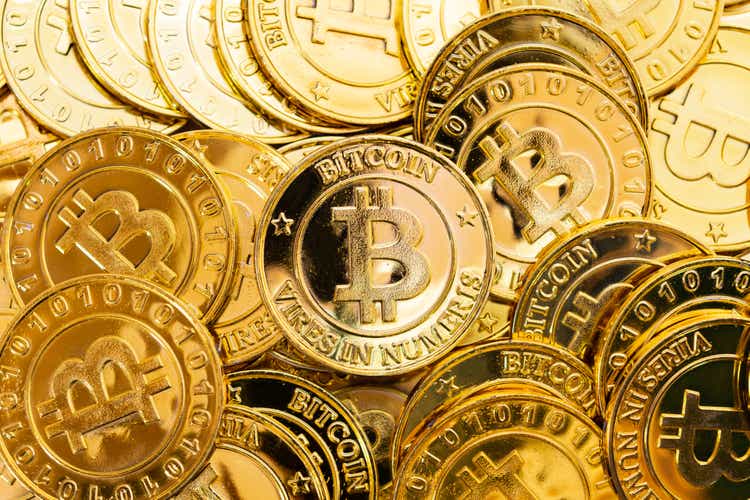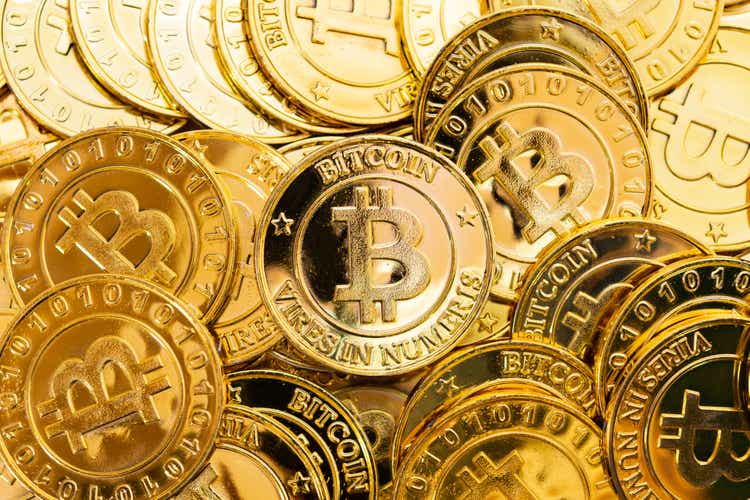[ad_1]
Tevarak
Introduction
With its inception date of May 11, 2021, the Bitwise Crypto Industry Innovators ETF (NYSEARCA:BITQ) (hereafter, the “Fund” or “BITQ“) enjoyed a few months of (late inning) crypto bull market gains before its returns fell off a cliff beginning in November 2021 (down more than 60% over the last year).
Notwithstanding the large drawdown, I am BEARISH on BITQ and crypto in general. My macro view, summarized in a prior article concerning a competitor ETF, is and remains as follows:
Based on proprietary indicators I follow (i.e., paid research subscription), I am currently expecting crypto bearishness to extend through the 3rd and 4th quarters of 2022. The space experienced an epic bubble and it will take time (and likely more pain) before the space is investable again (bear market rallies notwithstanding), particularly with the Fed raising rates and engaging in quantitative tightening, not to mention the recession that will come with the bubble hangover.
When my crypto bearishness changes to bullishness, BITQ is not the investment vehicle I would choose to gain exposure to the crypto industry because (1) its expense ratio is too high, particularly for a passive index; (2) its exposure to the crypto miners is not as robust as I would like; (3) the Fund faces heavy competition from more established asset managers like Fidelity and BlackRock, not to mention future competitors who will be entering the space (for example, Charles Schwab); (4) the Fund is overbought with a 50+% gain over the last month (as of the time of writing); and (5) the crypto space is still not particularly transparent and remains subject to fraud, as was highlighted in Matt Taibbi’s recent article concerning Circle Internet Financial, the maker of the USDC (USDC-USD) stablecoin.
In summary, while BITQ’s performance will likely be tied to the performance of the crypto market in general, I am bearish on this particular fund for the reasons noted above.
Fund Basics
Per its recent Fund Fact Sheet, the Fund’s primary strategy is to invest in a portfolio of companies that track the Bitwise Crypto Innovators 30 Index, a proprietary index designed by the Fund’s manager to measure the performance of leading companies in a growing crypto industry. In this regard, at least 85% of the Index is purported to be focused on so-called “pure-play” crypto companies, including (without limitation) Bitcoin (BTC-USD) and crypto-trading venues, crypto-mining and mining equipment firms, and service providers. Per the Summary-Prospectus, such “pure-play” companies derive more than 75% of their revenue from the crypto ecosystem.
The Fund’s assets under management are currently less than $50 million, at least according to the Seeking Alpha quote page. The manager of the Fund, Bitwise, is based in San Francisco, California.
Bitwise is one of the earlier players in the crypto asset management space. As of year-end 2021, Bitwise highlights assets under management (“AUM”), including BITQ, of over $1.3 billion. Nonetheless, I am confident that overall AUM for Bitwise is now well below $1 billion due to the bear market.
Expense Ratio and Competition
The expense ratio for the Fund is 0.85%. This is among the highest expense ratio I’ve seen in the space, and that includes active managers like the Amplify Transformational Data Sharing ETF (BLOK), which by comparison charges 0.71%. The other passive ETFs in the space all come in at 50 basis points (0.50%) or less, including Fidelity’s passive offering (FDIG) at 0.39%, BlackRock’s passive offering (IBLC) at 0.47% and VanEck’s passive offering at 0.50%. In short, BITQ’s high management fee is very problematic and the Fund is likely to find it difficult to attract funds over the longer term! I think the Fund will also have trouble competing with Fidelity, BlackRock, VanEck and, when its offering comes on board, Charles Schwab.
Holdings
As of August 4, 2022, the Fund’s top holdings included:
- MicroStrategy (MSTR) 12.45%
- Silvergate Capital (SI) 12.21%
- Coinbase (COIN) 12.20%
- Marathon Digital Holdings (MARA) 6.28%
- Riot Blockchain (RIOT) 5.43%
- Bakkt Holdings Inc (BKKT) 4.59%
- Canaan (CAN) 4.40%
- Galaxy Digital Holdings (GLXY:CA) 4.32%
- Core Scientific Class A (CORZ) 3.90%
- Bit Digital (BTBT) 3.58%
In terms of these holdings, I am looking for more exposure to the crypto miners. In this regard, in a recent article, I stated that:
When the tide turns and crypto winter ends, I have been giving a lot of thought as to how I want to add portfolio exposure. In this discernment process, I have determined that the best way [FOR ME] to do so will be via the crypto miners. I am done with wallets (it’s an age thing, being in my 50’s), I am done with the exorbitant fees of Coinbase (COIN), the regulatory issues of BlockFi, the bankruptcy of Voyager, and so on an so forth with respect to the centralized crypto exchanges. The miners, on the other hand, are leveraged to crypto, Bitcoin in particular, and I can trade them via my brokerage account without any fees and without administrative and tax headaches.”
This interview also helped me better understand the mining industry.
According to the Fund’s Fact Sheet (linked above), the crypto miners make up 31.31% of the Fund (as of June 30, 2022). While this is ok relative to other diversified crypto funds, I’ll be looking for more concentrated exposure to the miners when my general view on crypto turns bullish. [Notably, I do recognize that there are others who do not have a favorable view of the crypto mining industry.]
I’m also troubled by some of the Fund’s crypto holdings. For example, Canaan Inc. I wrote a bearish article on the Company back in March of 2021 and the company is now down roughly 90% since that time. I remain skeptical of Chinese crypto companies.
Similarly, I am skeptical of companies like Galaxy Digital because of its CEO’s promotion of the Luna (LUNA-USD) Ponzi scam. With operating losses as far as the eye can see, Bakkt Holdings (another BITQ top ten holding) also appears to have been a venture capital pump and dump stock; its revenues continue to decline and guide down.
At the end of the day, I do not see what’s so special about the Bitwise Index being passively followed by the Fund, particular with its emphasis on source of revenue (rather than profits). Moreover, if the Fund’s manager (or an affiliate of the Fund’s manager) creates the index, is it really passive?
Conclusion
Being overbought (having risen more than 50% in the past month and above $10 at the time of writing), coupled with my bearish macro views of crypto over the next 4-6 months, cause me to rate BITQ a SELL. Moreover, given how expensive the Fund is relative to other active and passive crypto ETF offerings, I do not see why an investor would opt for BITQ. Of course, do your own due diligence and keep in mind that fraud in the space has not likely been fully purged.
[ad_2]
Source links Google News

